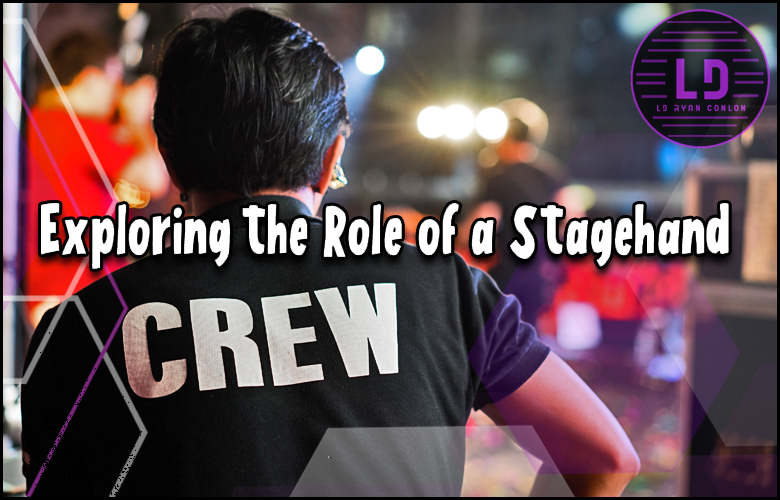
Last Updated on May 11, 2025 by LD Ryan Conlon | 🕒 6 min Read Time
Ever wondered about the marvel that unfolds when the theater lights dim?
The meticulously designed sets, the perfectly timed light changes, or the seamless scene transitions?
Behind every awe-inspiring theatrical performance lies tireless work from a team of unsung heroes – Stagehands.
In this blog post, we delve behind the scenes, unmasking the role of these critical backstage maestros, their day-to-day duties, and the responsibilities they shoulder to ensure that every act goes off without a hitch!
A stagehand is responsible for various behind-the-scenes tasks in the entertainment industry, such as setting up scenery, lights, sound equipment, props, rigging, and special effects for productions. They are skilled in multiple disciplines like rigging, carpentry, painting, stage electrics, lighting, audio, video/projection, and props. Stagehands work closely with directors and other designers to bring their creative vision to life. Their role may vary depending on the venue and production, but they play a crucial part in ensuring smooth and successful performances.
Understanding the Stagehand Role
The world of theater, film, television, and live performances is a magical place where stories come to life.
But behind the scenes, there’s an army of talented individuals working tirelessly to ensure that the show runs smoothly. And at the heart of this bustling backstage environment is the stagehand.
A stagehand is a jack-of-all-trades, an unsung hero who plays a crucial role in bringing productions to life.
They are responsible for setting up scenery, lights, sound, props, rigging, and special effects.
With their diverse skillset, they support various disciplines like rigging, carpentry, painting, stage electrics, stage lighting, audio, video/projection, and props.
Picture this: A grand production with elaborate sets that transport the audience into different worlds.
It’s the stagehands who work tirelessly during rehearsals and performances to move these intricate pieces around seamlessly.
They ensure that the set changes happen swiftly and discreetly so as not to interrupt the flow of the story.
Stagehands are often behind-the-scenes wizards who possess a deep understanding of the technical aspects of production.
They collaborate closely with directors, lighting designers, set designers, costume designers, and sound designers to bring their creative visions to life.
Each production comes with unique challenges and requirements that demand adaptability and quick problem-solving skills from these dedicated individuals.
In terms of employment opportunities, stagehands may work on a show-by-show basis or become part of major theater or studio staff teams.
Many stagehands are union members and have specialized roles within their respective departments.
When a show travels or goes on tour, some stagehands travel with it while others support shows at each new venue.
Now that we have gained insight into the role of a stagehand let’s dive into the specific job duties and responsibilities they undertake backstage.
- Stagehands are the unsung heroes of the entertainment industry, playing a crucial role in bringing productions to life. They possess a diverse skillset and are responsible for setting up scenery, lights, sound, props, rigging, and special effects. Stagehands collaborate closely with various production team members and possess deep technical knowledge. They work behind the scenes to ensure seamless set changes and adaptability to unique production challenges. Employment opportunities for stagehands range from show-by-show basis to becoming part of major theater or studio staff teams.
Job Duties and Responsibilities
Stagehands are the engine that drives the entire production behind the scenes.
Their job duties and responsibilities can vary depending on the specific discipline, venue, and production requirements.
Let’s explore some common tasks that stagehands undertake:
- Moving and Set Up: Stagehands are expert movers who handle the heavy lifting behind the scenes. They transport equipment, set up scenery and props, and construct or dismantle sets as needed.
- Rigging: Rigging is a critical aspect of stagecraft that involves building structures and using safety gear, similar to what one might find in mountain climbing. Riggers ensure that everything from actors flying across the stage to massive set pieces hanging overhead is secure and safe.
- Carpentry: Carpenters in the theater world are responsible for constructing new set pieces or modifying existing ones according to the production’s requirements. They work closely with set designers to bring their visions to life.
- Lighting and Electrics: Electricians, also known as lighting technicians, play a vital role in setting up all the lights required for a production. They program light designs into lighting consoles, run follow spots (spotlights), and ensure that all electrical equipment is safely installed and functioning properly.
- Audio and Video Support: The audio and video departments are also part of the stagehand’s domain. They assist in setting up sound systems, microphones, speakers, video monitors, projectors, and any other audiovisual needs of a production.
These are just a few examples of the myriad responsibilities shouldered by stagehands.
Their adaptability, problem-solving skills, attention to detail, physical stamina, teamwork, and ability to work under pressure make them an indispensable part of any successful production.
Although the work can be physically demanding or seasonal due to intermittent employment opportunities, it provides valuable skills and experience for those passionate about the industry.
Imagine being backstage during the final moments before the curtain rises, witnessing the chaos, stress, camaraderie, and drama that exist among stagehands.
It’s a world where everyone works together like a well-oiled machine, each playing their part to create magic on stage.
Types of Stagehands
The world of stage production is a bustling hub of activity, and to bring a performance to life, different types of stagehands come together to work their magic behind the scenes.
Let’s explore some common roles that exist within the realm of stagehands:
Running Crew Members: These are the backbone of any production, responsible for the smooth execution of backstage operations.
They handle various tasks like moving set pieces, props, and equipment during scene changes, ensuring everything runs seamlessly.
Theatrical Technicians: With expertise in specific technical areas, theatrical technicians specialize in disciplines such as lighting, sound, or audio/video.
They work closely with designers to set up equipment and execute technical cues during performances.
Fly Captains: These specialized stagehands oversee the operation of the fly system, which controls the movement of scenery and props suspended from above.
They ensure swift and safe transitions between scenes using rigging techniques.
Kuroko: Derived from traditional Japanese theater, kuroko are silent characters dressed head-to-toe in black who assist in various aspects of a performance—moving props or even acting as human scenery.
Their discreet presence enhances the seamless flow of a production.
Stagehands can work across different venues and genres—from traditional theaters to outdoor festivals, film sets, and television studios.
Each role requires specific skills and expertise to meet the demands of a particular production.
It’s important to note that while each role has its own unique responsibilities, stagehands often collaborate and assist one another as needed.
The nature of backstage work fosters an environment where teamwork and flexibility are paramount.
Essential Skills for Stagehand Work
Behind every awe-inspiring performance lies a team of skilled professionals working diligently behind the scenes.
Stagehand work is no exception; it requires individuals with a diverse range of technical and physical capabilities.
Let’s dive into some essential skills necessary for this dynamic profession:
Technical Expertise: Stagehands must possess knowledge in various technical areas, such as rigging, carpentry, painting, stage electrics, and audio/video.
Familiarity with tools and equipment used in these disciplines allows them to execute tasks efficiently.
Physical Stamina: Working backstage can be physically demanding. Stagehands often lift heavy objects, move set pieces swiftly during scene changes, and work on their feet for extended periods.
Good physical stamina is necessary to thrive in this fast-paced environment.
Problem-Solving Skills: Backstage glitches are inevitable, and stagehands need to be resourceful problem solvers.
Whether it’s a malfunctioning lighting fixture or a last-minute prop adjustment, they must think quickly and find workable solutions under pressure.
Attention to Detail: Precise execution is crucial in stage production. Stagehands must meticulously follow instructions, cues, and timing to ensure the show proceeds flawlessly.
Attention to detail is essential when setting up intricate scenes or operating complex technical equipment.
Collaboration and Adaptability: Backstage work involves close collaboration with directors, designers, and fellow stagehands.
Effective communication skills and the ability to adapt to changing circumstances smoothly contribute to a cohesive team effort.
Stagehand work encompasses much more than just moving props or setting up equipment; it requires a wide range of skills that contribute to the success of a performance.
Consider the story of Emily, a stagehand who was part of a theater company putting on a Shakespearean play.
As she worked alongside her colleagues during rehearsals and performances, she realized the importance of her technical expertise in handling lighting cues and ensuring smooth scene transitions.
Her physical endurance enabled her to swiftly move large set pieces between acts without missing a beat.
Emily’s problem-solving skills came into play one evening when an actor’s costume ripped minutes before they were due on stage.
With her attention to detail and resourcefulness, she quickly found needle and thread to make a discreet repair, saving the day.
The combination of these essential skills makes stagehands indispensable contributors to the world of performing arts.
As we continue our exploration, let’s now delve into the technical and physical capabilities required for effective stagehand work.
- According to the U.S Bureau of Labor Statistics, employment for set and exhibit designers, including stagehands, is projected to grow 6% from 2019 to 2029.
- A 2019 report by Payscale suggests that the average salary for a theatrical stagehand in the United States is around $18.69 per hour.
- As per an estimate by the International Alliance of Theatrical Stage Employees (IATSE), over 100,000 people work as stagehands across North America.
Technical and Physical Capabilities
Being a stagehand requires a unique combination of technical skills and physical capabilities.
The job involves working behind the scenes to ensure that everything runs smoothly during performances or events.
Let’s explore some key technical and physical capabilities that are essential for stagehands to excel in their roles.
First and foremost, stagehands need to have a good understanding of basic technical principles.
This includes knowledge of rigging, carpentry, painting, stage electrics, lighting, audio, video/projection, and props.
They should be comfortable with using various tools and equipment related to these disciplines.
For example, riggers are responsible for building structures and using safety gear similar to what is used for mountain climbing.
Construct and set up scenery, while electricians handle all aspects of lighting design and operation.
Aside from technical skills, stagehands must also possess physical capabilities that enable them to perform their duties effectively.
The work can be physically demanding and requires stamina, strength, and agility.
Stagehands often have to lift heavy objects such as set pieces or speakers, move equipment around the stage or backstage area quickly, and climb ladders or scaffolding when necessary.
Moreover, they must withstand long hours of standing or moving around without experiencing fatigue.
Now that we understand the technical and physical capabilities required for a stagehand role, let’s delve into the responsibilities associated with working with stage equipment.
Working with Stage Equipment
Stagehands play a critical role in the setup and maintenance of stage equipment.
They are responsible for ensuring that all equipment is properly installed, operational, and in good working condition before each performance or event.
Here are some key aspects of working with stage equipment that stagehands need to be proficient in:
- Set-up: Stagehands are involved in setting up various equipment such as lighting fixtures, sound systems, microphones, projectors, screens, and props. They need to have a good understanding of the technical requirements and be able to place equipment in the correct positions as specified by the design team.
- Maintenance: Regular maintenance of stage equipment is crucial to ensure its proper functioning. Stagehands are responsible for inspecting, cleaning, and repairing equipment as needed. For example, they may need to change light bulbs, replace batteries in wireless microphones, or fix any issues with audio cables.
Imagine a stagehand named Sarah. Before a theater performance, she meticulously checks each lighting fixture ensuring all bulbs are working and properly focused.
In addition, she tests all microphones to ensure they’re transmitting clear sound. These tasks require attention to detail and technical knowledge.
- Troubleshooting: During performances or events, stagehands need to be prepared for any technical issues that may arise. They should be able to troubleshoot problems quickly and effectively without disrupting the show. This could involve addressing issues with sound levels, adjusting lighting settings, or resolving equipment malfunctions.
- Strikes and Load-outs: After an event or performance concludes, stagehands are responsible for dismantling the set and removing all equipment from the venue. This process, known as a strike or load-out, requires coordination and efficiency to ensure that everything is packed safely and transported back to storage without damage.
Working with stage equipment is just one aspect of a stagehand’s responsibilities.
However, it highlights their integral role in creating a seamless and captivating experience for performers and audiences alike.
Safety Considerations in Stagehand Work
Being a stagehand involves working in a dynamic and fast-paced environment where safety is of paramount importance.
As stagehands are responsible for various behind-the-scenes tasks, it is crucial to be aware of the safety considerations specific to their line of work.
One primary aspect of ensuring safety is proper training and knowledge.
Stagehands are skilled professionals who undergo rigorous training in multiple disciplines such as rigging, carpentry, painting, stage electrics, lighting, audio, video/projection, and props.
This training equips them with the necessary skills to navigate potential hazards and maintain a safe working environment.
When it comes to physical safety, stagehands must remain vigilant at all times.
They may encounter risks associated with heavy lifting, moving equipment, or maintaining structures.
By adhering to proper lifting techniques and using appropriate tools and equipment, such as gloves and harnesses, stagehands can mitigate the risk of strain or injury.
For instance, when setting up scenery or prop pieces that require multiple people’s assistance due to their weight or size, stagehands must communicate effectively to ensure coordinated movements and avoid accidents.
To put it simply: Safety should always come first for stagehands.
By following proper protocols and being well-versed in safety procedures, they can create a secure environment for themselves and others involved in the production.
Now let’s explore some potential workplace hazards that stagehands might encounter during their work behind the scenes.
Potential Workplace Hazards
While working backstage, stagehands face various potential hazards depending on their specific roles and responsibilities.
It is crucial to identify these risks early on and take necessary precautions to prevent accidents or injuries.
One notable hazard for stagehands involved in rigging is the risk of falls.
Rigging involves building structures and utilizing safety gear similar to that used for mountain climbing.
Stagehands who work at heights must be well-trained and knowledgeable about safety measures, such as wearing harnesses, using appropriate hardware, and carefully inspecting rigging equipment before use.
Another common hazard in stagehand work relates to electricity.
Electricians or lighting technicians who handle wiring, lights, and power supply must be vigilant about electrocution risks.
This entails proper grounding techniques, following electrical codes, and ensuring safe practices when handling live electrical systems.
For instance, a stagehand working with lighting fixtures should know how to safely handle high-voltage cables, use insulated tools, and adhere to lockout/tagout procedures when making adjustments or repairs.
Furthermore, stagehands who work with machinery or heavy equipment should receive proper training on how to operate them safely.
This includes understanding safety protocols for equipment like forklifts or lifts used to move large set pieces.
It is crucial to maintain clear communication with team members to prevent accidents during these operations.
Overall, a thorough understanding of potential workplace hazards combined with appropriate safety training allows stagehands to navigate their roles while minimizing risks.
By prioritizing safety at all times, stagehands can continue creating memorable performances while protecting their well-being and that of others involved in the production.
Moving Beyond the Curtain: Opportunities in Film and Entertainment
As a stagehand, you possess valuable skills and experiences that extend beyond the realm of traditional theater.
The world of film and entertainment offers numerous exciting opportunities for those seeking to broaden their horizons and explore new avenues within the industry.
Let’s take a closer look at some of these opportunities.
Film Sets: One potential avenue to venture into is working on film sets.
Film production requires a multitude of talented individuals, including skilled stagehands who can bring their expertise to ensure smooth operations behind the scenes.
You may find yourself setting up elaborate sets, handling props, coordinating lighting and sound equipment, or assisting with camera rigging.
Working on film sets can provide you with exposure to new technologies and production techniques while being part of creating cinematic masterpieces.
Imagine being involved in a major motion picture production, where you work alongside renowned directors, cinematographers, and actors.
You could find yourself erecting massive green screens for stunning visual effects or setting up intricate practical effects that captivate audiences on the big screen.
The experience gained from working on such projects can be invaluable in expanding your skill set and opening doors to further opportunities in the film industry.
Television Studios: Another avenue worth exploring is television studios.
With the rise of streaming platforms and the ever-expanding television landscape, there is an increasing demand for skilled professionals who can contribute to the creation of compelling content.
Whether it’s a live studio audience show or a prerecorded series, your expertise as a stagehand can aid in seamless production by ensuring the efficient setup of sets, managing lighting setups, and facilitating smooth scene transitions.
Picture yourself as part of a team working on a popular late-night talk show or a hit drama series.
From collaborating with set designers to constructing versatile sets that accommodate various scenes to operating advanced lighting systems for optimal visual impact, your contributions as a stagehand can play a crucial role behind the scenes.
This experience can be enriching and provide opportunities to work on a variety of productions, expanding your professional network along the way.
Concerts and Live Events: Beyond the realms of theater and screen, there is also a demand for skilled stagehands in the world of live events and concerts.
From music festivals to large-scale corporate events, these immersive experiences require meticulous planning and execution in order to deliver unforgettable moments for audiences.
Your adaptability, teamwork, and technical skills can prove invaluable in setting up stages, managing audio-visual equipment, and ensuring smooth transitions between performances.
Imagine being part of a team responsible for setting up the stage at a massive music festival that attracts thousands of attendees.
The adrenaline rush as you work alongside talented musicians and performers, ensuring everything is perfect before showtime, is both exhilarating and gratifying.
You may find yourself collaborating with renowned production companies or even supporting world tours with internationally acclaimed artists.
The opportunities within concert and live event production are vast, allowing you to continuously challenge yourself and grow professionally.
Venturing beyond the traditional theater opens doors to exciting new possibilities in film sets, television studios, concerts, and live events.
These avenues not only allow you to apply your existing skills but also provide opportunities for growth, networking, and exposure to different aspects of the industry.
Related Posts
- How to Get Started as a Stagehand Beginner’s Guide
- Union vs Non-Union Stagehand Jobs: Pros and Cons
- What is a Stagehand? Everything You Need to Know
[scriptless]
Pins for Pinterest
If you like what you see, feel free to share some love on Pinterest ❤️

Ryan Conlon is a highly experienced Corporate Freelance Lighting Designer with two decades of dedicated work in the entertainment industry. With a passion for creating captivating lighting experiences, Ryan has contributed his expertise to numerous corporate meetings, stage productions, concerts, and events throughout his career.










